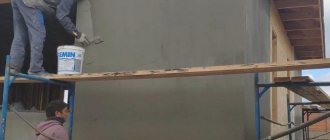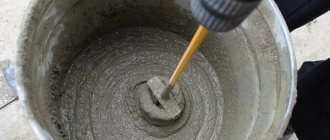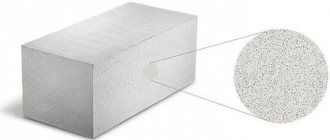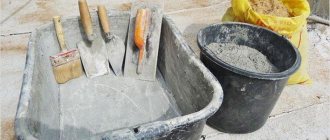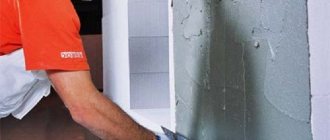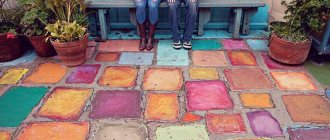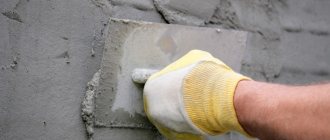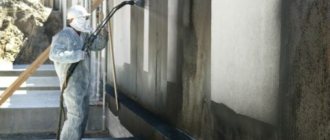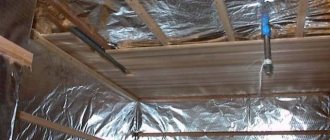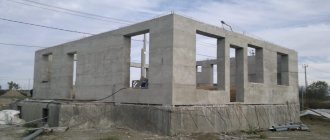Today, manufacturers of paint and varnish products offer a wide range of materials. Let's look at how to paint concrete. Let's look at the criteria and requirements for compositions in relation to walls, facades, walkways and architectural elements. Let's get acquainted with the technology of painting concrete surfaces. After reading the article, you will be able to make the right choice of paint to solve a specific problem.
Special paint for concrete floors Source kraski-kapitel.ru
Painting inside and outside, what's the difference?
There is a difference when painting concrete walls inside and outside. These are completely different conditions. On the street, the wall is exposed to negative influences. As for coloring, there are two differences:
- Temperature conditions. Concrete indoors is in “greenhouse” conditions and is not exposed to sudden changes and frost. The same cannot be said about external surfaces. Therefore, work there must be carried out at temperatures above 5 ℃. Also, the process is performed in cloudy weather, when direct sunlight does not hit the concrete.
- Lead time. Painting concrete inside can be done at any time. And external work must be carried out depending on the weather and time of day, so that morning and evening dew does not form.
If these conditions are met, the paint applied to the concrete outside will not crack and will last much longer.
Ceiling paint
Ceiling treatment
Non-toxic water-based paint is used for the ceiling. It is worth noting that it does not form a very durable coating that is not resistant to moisture, therefore, it is most often used for the ceiling plane, where the risk of damage due to mechanical action is minimal.
This paint is low cost and easy to use. For tinting ceilings in rooms with high humidity (kitchen and bathroom), a waterproof latex-based composition is used.
Selection of paint and varnish material
Previously, it was easier to choose paint, since the assortment was scarce. There are many paints on store shelves today, but not all of them can be used on concrete. It all depends on the operating conditions. Having considered the features, advantages and disadvantages, you can choose what to paint your concrete floor, ceiling or walls.
Oil-based paints and varnishes
The products are made on an oil base. It has long been used for painting interior and exterior surfaces. However, due to the toxic composition due to solvents, it is better not to use it inside. Has a pungent odor. Advantages:
- Affordable price.
- Withstands the negative impact of the street, is not afraid of moisture and other atmospheric factors.
- A durable and beautiful coating is created.
- Oil-based paint can be susceptible to dust and dirt, but it is easy to clean with gentle products.
- Long service life.
- Good adhesion.
- Large selection of colors.
Flaws:
- Strong smell. Requires waiting for weathering before moving in.
- Toxicity.
- Long drying time, 24 hours or more.
- Has low elasticity, if the concrete cracks, the paint will tear.
- The color is unstable. The drying oil will turn yellow as it is used.
To conclude, oil paint for concrete walls is good if you need to repaint a storage area or other exterior surfaces. After all, it is cheap and practical. But it is better not to use it for work around the house or garage.
Water based paint
Water emulsion and dispersion are an excellent option for interior painting. It is water-based, so it has many advantages. There are no harmful substances in the composition. It can be used to paint concrete walls, ceilings and interior floors. There are façade paints for exterior use. The packaging indicates for what purposes the composition can be used.
Advantages:
- Environmentally friendly.
- Not afraid of moisture.
- Dries quickly.
- Has no smell.
- Easy to use.
- Paints can be sold in white and tinted by hand.
As for the disadvantages, the only thing we can note is the cost. It is low, but oil formulations are cheaper.
Acrylic paint
A universal option, it can be used to paint concrete ceilings, floors, walls inside and outside. It is based on acrylates, which give the composition special properties. The packaging indicates for what purposes it is used: “Ceiling”, “Facade”, “For walls”. Acrylic compositions are also used for artistic painting.
Advantages:
- Environmentally friendly.
- Not afraid of mechanical impact.
- Elastic.
- Vapor permeable, the walls will breathe without condensation.
- Has a stable color throughout its entire service life.
- Possibility of tinting.
- Long service life.
- Not afraid of moisture.
The downside is the cost. It is high. But if you consider the benefits, the price is justified. When choosing what to paint a concrete wall with, you can safely buy alkyd compounds.
Silicate based
It is also called glass paint, as it is based on liquid glass. Thanks to this, a durable film is created on the surface after painting, protecting the structure of the concrete surface. Suitable for indoor and outdoor surfaces.
Important! To find out the consumption of facade paint per 1m2, you need to look at the packaging. There are specific numbers there.
Advantages of silicate paints:
- Not afraid of chemical exposure.
- Has stable color.
- Strong and durable.
- Protected from fire.
- Not afraid of moisture.
- Resistant to biological factors (development of mold and other microorganisms).
- Very wear-resistant.
Their disadvantages are that they are expensive and contain toxic substances, so when working with them, it is important to take care of respiratory protection.
Advice! There is a rubber-based paint specifically for concrete surfaces. It is often used to paint concrete floors, as it creates a soft coating on the surface. It is elastic and not afraid of small cracks. She also perfectly tolerates all negative influences.
Impregnations for concrete
Painting walls requires preparation. Before the process, it is better to coat the surface with a special impregnation. This will preserve the surface from dirt, moisture and aggressive environments. The impregnation will penetrate the concrete structure and strengthen it. The compositions are made on an acrylic base, polyurethane or epoxy resins. In addition, preliminary application will reduce paint consumption. After all, concrete has a porous structure and absorbs liquids well.
After applying the impregnation, the wall will dry in a few hours (exact time on the packaging). After this, the wall, floor or ceiling will be ready for painting. The impregnation itself is transparent and may also have additional properties, for example, antiseptic. Having considered the features of paints, you can choose what to paint your concrete floor with.
Briefly about the main thing
Paint for concrete can be universal, for work outdoors or at home, for floors, walls, ceilings, facades, foundations and road surfaces.
Thinners for materials can be water or organic compounds, products of the petroleum industry.
Natural or synthetic latex, acrylic, alkyd, vinyl, phenolic or epoxy resin, polyurethane and liquid glass can be used as a base.
There are three types of concrete coloring technology: superficial, deep, and with the addition of dye at the stage of preparing the cement mortar.
How to prepare concrete for painting
Concrete is a surface with its own characteristics. Therefore, in order for the painting process to be ideal and the layer to last for many years, it is important to take care of high-quality preparation. It depends on several factors, for example, whether it is a new surface or an old one. So, before painting concrete, you need to perform general preparation work:
- Check the moisture content of concrete walls, floors or ceilings. To do this, a square of polyethylene film is glued to the concrete. Dimensions 1x1 m, fixation is done with tape. The condensation that forms on the film over time indicates that the wall is damp and cannot be painted. Better to wait.
- Remove the old layer of finishing, if any. This can be done in several ways: sandblasting, special chemicals or mechanically.
- Next, the wall is cleaned of dust, dirt, grease stains and soot. Dirt and dust can be easily removed with water, soot can be removed with a calcined solution, and a solution of copper sulfate (15%) can deal with rust.
- Use pumice or sandpaper to remove unevenness and roughness on the concrete.
- To strengthen it, before painting the wall like concrete, you can treat it with fluate (acid-salt solution).
- Finally, apply a deep penetration primer. It penetrates the pores of concrete, filling them. This will reduce paint consumption and also improve adhesion to the surface.
As for cleaning the old finishing coating, this point needs to be considered in more detail. Since residues can ruin both the appearance of the concrete coating and its service life. If you need to clean a small area, then a mechanical method is used. You have to work manually for a long time and carefully, but the finished result is worth it. To do this, use a chisel, scraper, or spatula. When the floor or wall has a large area, it is better to use a power tool (grinder, drill). Special nozzles are used.
Advice! The process is accompanied by the formation of dust and dirt. Therefore, protective equipment must be used to protect the respiratory system and mucous membranes.
After cleaning, you need to inspect the concrete surface to see if there are any defects left. You will often find that the wall is crooked. In this case, you may need to putty the concrete walls before painting. Any changes after painting will be visible, especially when light hits the wall. Therefore, the wall needs to be leveled. If the unevenness is small, it is enough to walk over the surface with putty or even seal individual areas.
As for the primer, it must be applied to a smooth and clean surface. Ideally, choose a composition with antiseptic properties to avoid the formation of mold and mildew. At the same time, if the facade paint is from Knauf, then it is better to buy the primer from the same company.
What features does concrete pavement have?
Concrete coating has the following advantages:
- practicality, low price;
- high strength index;
- easy installation and care;
- resistance to wear and generally any negative influences.
Concrete surfaces are often used on streets and industrial premises. After all, such a material can withstand high loads even under extreme conditions.
The disadvantages of concrete include the fact that dust appears on it too quickly during use. Laying an additional layer of laminate helps get rid of this problem. Linoleum or carpet are also accepted as acceptable alternatives. But painting is the most optimal solution.
Using this technology will allow you to forget about dust formation at minimal cost. The resistance of concrete to wear after additional processing improves, as does its appearance. All that remains is to choose the appropriate composition.
DIY technology for painting concrete walls
Painting a concrete floor or walls is not difficult, but has several nuances. For example, if the paint is very thick, then it is better to dilute it. A solvent is used for this (each type of paint has its own). The painting process is performed using rollers and brushes. Large areas are treated with rollers, hard-to-reach areas with brushes. In order for the color to be rich and hide the surface of the concrete, you will need to apply 2-3 layers.
Instructions on how to paint a concrete ceiling, walls or floor with your own hands:
- Unpainted areas must be protected. For example, when painting walls and ceilings, newspapers or plastic film are covered on the floor. You can use masking tape on the wall to protect window and door openings.
- To prevent paint and varnish material from getting into your eyes, it is better to wear glasses. A respirator will protect the respiratory tract.
- Open the paint and stir. You can use it straight from the jar, but this is inconvenient; it is usually poured into a smaller container or directly into the roller tray.
- When working with a brush, it is important not to lower it entirely into the paint and varnish material, but only a third. Remove excess composition. This way there will be no smudges left on the wall.
- It is better to start working from a corner and hard-to-reach areas that are treated with a brush. Cross strokes. Movements from top to bottom and left to right. The main task is to evenly distribute the composition over the surface of the concrete.
- A roller is used. It’s easy for them to work on even large areas, and the tray will help control the amount of paint used. Do not move quickly, otherwise the paint may splatter.
- You need to start from the top and work your way down. Movements on concrete are only vertical up and down.
- When the first layer is applied, you need to wait for it to dry completely. This time is indicated on the paint packaging.
Subsequent layers are applied identically. As you can see, painting concrete is not as difficult as it seems. It is only important to carefully prepare the surface, choose what to paint with and follow the instructions. But by doing the work yourself, you can save a lot of money. If everything is done correctly, the painted surface will delight you for many years.
